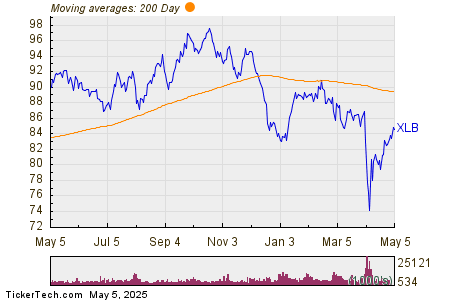The Walt Disney Company to Report Q2 Fiscal 2025 Earnings Soon
The Walt Disney Company (DIS) is set to release its second-quarter fiscal 2025 results on May 7.
Revenue and Earnings Estimates
The Zacks Consensus Estimate anticipates revenues of $23.14 billion, reflecting a modest growth of 4.78% from the previous year’s reported figure. Additionally, the consensus estimate for earnings per share has decreased by a penny over the last 30 days to $1.18, indicating a year-over-year decline of 2.48%.

Image Source: Zacks Investment Research
In its last reported quarter, Disney achieved an earnings surprise of 22.22%. The company has consistently surpassed the Zacks Consensus Estimate in each of the trailing four quarters, averaging a surprise of 12.67%.
Price and EPS Surprise Overview

Earnings Expectations for DIS
Our model currently does not indicate an earnings beat for Disney this time. A combination of a positive earnings ESP and a Zacks Rank of #1 (Strong Buy), #2 (Buy), or #3 (Hold) generally enhances the chances of exceeding expectations. Unfortunately, DIS has an earnings ESP of -1.48% and carries a Zacks Rank of #4 (Sell).
Factors Impacting Upcoming Results
As Disney prepares for its second-quarter fiscal 2025 earnings report, several concerning factors may prompt investors to reconsider their exposure to the stock, despite some positive trends in its streaming and content divisions.
The Entertainment segment exhibited strong performance in the fiscal first quarter, earning $1.7 billion in operating income—a significant 95% year-over-year increase. Nonetheless, sustaining this momentum could prove challenging. In the second fiscal quarter, Disney anticipates a $100 million adverse impact on its Sports segment operating income due to increased college sports costs and the inclusion of additional NFL games. Furthermore, the company projects an unfavorable write-off of over $50 million from exiting its Venu joint venture.
Our estimates for Entertainment revenues—including Linear Networks, Direct-to-Consumer, and Content Sales/Licensing—are set at $10.31 billion, indicating a 5.2% increase year over year.
The Experiences segment, covering Disney’s theme parks and cruise line operations, also faces hurdles. The fiscal second quarter is expected to incur over $40 million in pre-opening expenses related to Disney Cruise Line. For the entire fiscal year, pre-opening expenses connected to this expansion are projected to exceed $200 million, posing immediate financial strain without immediate revenue gains.
Our model estimates the Experiences segment revenues at $8.93 billion, reflecting a 6.4% growth year over year.
Despite signs of recovery in Disney’s streaming services—especially with the ESPN tile on Disney+—the company anticipates a modest decline in Disney+ subscribers compared to the previous quarter, highlighting ongoing challenges in subscriber retention.
The recent launch of original programming for Disney+, including the daily sports show SC+ and the 24/7 Simpsons stream, signifies strategic investments that may not provide immediate returns. Additionally, the recent agreement to merge Hulu+ Live TV assets with fuboTV introduces further complexity and risk.
Disney’s acquisition of a 70% stake in Fubo will require regulatory and shareholder approvals, injecting uncertainty regarding the timing and potential hurdles. Although this deal may offer long-term benefits, it adds another layer of complexity to Disney’s business transformation.
Financially, Disney posted solid results in the first quarter of fiscal 2025, marked by a 44% increase in diluted earnings per share excluding certain items, 5% revenue growth, and a 31% rise in total segment operating income. However, these results may have set a high bar for the upcoming second quarter, given the anticipated challenges highlighted.
Looking ahead, management aims for high-single-digit adjusted EPS growth for fiscal 2025 compared to fiscal 2024, but achieving this goal will depend on effective execution in various areas. Given the expected challenges and valuation concerns in the second quarter, investors might consider taking profits before the earnings report and reevaluating their positions at more favorable entry points once the outlook for fiscal 2025 becomes clearer.
Stock Performance & Valuation
DIS shares have declined by 16.9% year-to-date, underperforming both the broader Zacks Consumer Discretionary sector and its peers. Disney competes in a tough streaming market dominated by major players such as Amazon (AMZN)-owned Amazon Prime Video and Netflix (NFLX), along with rising competitors like Apple’s streaming service, Comcast (CMCSA)-owned Peacock, and HBO Max.
Year-to-Date Performance
Disney Faces Valuation Challenges Ahead of Q2 Earnings
Disney is currently trading at a premium, with a forward 12-month price-to-sales (P/S) ratio of 1.72X, surpassing the Zacks Media Conglomerates industry’s average of 1.39X. This indicates a stretched valuation. Furthermore, Disney’s debt stands at $45.3 billion, contrasting sharply with its cash, cash equivalents, and marketable securities balance of only $6 billion.
P/E Ratio Highlights Valuation Concerns

Image Source: Zacks Investment Research
Examining Investment Outlook Prior to Q2 Results
Disney’s premium valuation appears increasingly hard to defend ahead of its fiscal second-quarter results. Although the company performed well in the previous quarter, several challenges lie ahead. The Sports segment is expected to incur a $100 million impact from college sports costs, along with an additional $50 million write-off related to exiting the Venu joint venture. Pre-opening costs for the Disney Cruise Line will add another $40 million burden. Moreover, management projects a slight decline in Disney+ subscribers, undermining momentum in the streaming sector. The recent Fubo acquisition adds regulatory uncertainty, while competition is intensifying across all business segments. Despite strategic investments in original content and platform improvements, Disney’s current valuation does not seem to reflect these immediate challenges. Investors may want to consider reducing their exposure before the fiscal second-quarter earnings disclose the full extent of these operational headwinds.
Concluding Remarks
Disney’s near-term outlook seems precarious despite strong first-quarter results. With anticipated Sports segment headwinds totaling $150 million, additional pre-opening expenses from the Cruise Line, and expected declines in Disney+ subscribers, the company faces multiple operational pressures. These issues, combined with uncertainties from the Fubo acquisition and mounting competition across all segments, indicate that Disney’s premium valuation may be increasingly unjustifiable. Investors should carefully assess their positions before the upcoming fiscal second-quarter results potentially highlight the full impact of these challenges.
The views and opinions expressed herein are those of the author and do not necessarily reflect those of Nasdaq, Inc.


